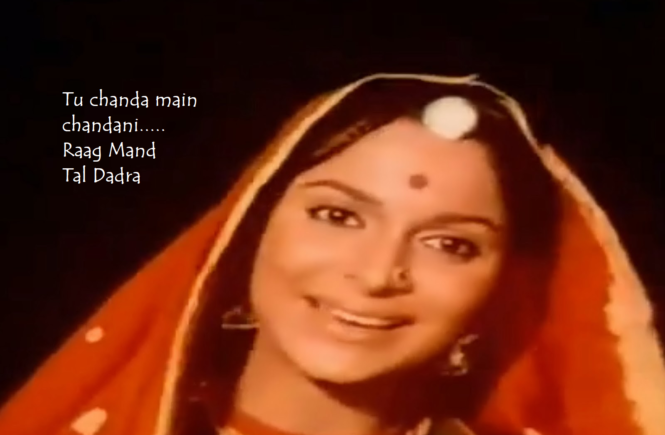Raaga Based Song of the Day: Tu chanda main chandani ….
Raag Mand, Tal Dadra
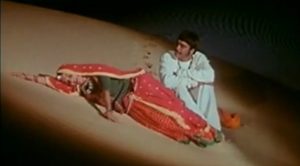 Ladies and gentlemen, tonight’s song is special on several counts. Here are some of them in no particular order. The first reason is the composer Jaidev. He did it to Sunil Dutt and Waheeda Rehman in the 1963 movie Mujhe Jeene Do with the song: Raat bhi hai kuchh bheegi bheegi. Eight years later, he did it again in the 1971 movie Reshma Aur Shera with this song.
Ladies and gentlemen, tonight’s song is special on several counts. Here are some of them in no particular order. The first reason is the composer Jaidev. He did it to Sunil Dutt and Waheeda Rehman in the 1963 movie Mujhe Jeene Do with the song: Raat bhi hai kuchh bheegi bheegi. Eight years later, he did it again in the 1971 movie Reshma Aur Shera with this song.
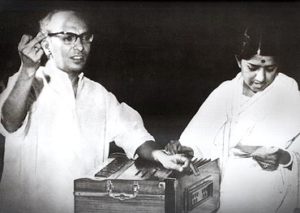
The second reason is the singing in Raag Mand by Lata Mangeshkar. She is my favourite female singer and she simply floored me with her singing as she did in the 1999 movie Lekin’s song in the same raaga and tal that I gave you earlier: Kesariya balma (Please see: ‘Raaga Based Song Of The Day #24‘). The third are the histrionics of Sunil Dutt and Waheeda. Eight years ago they did it in Moni Bhattacharjee’s Mujhe Jeene Do. Here they are back with Reshma Aur Shera, a movie produced and directed by Sunil Dutt.
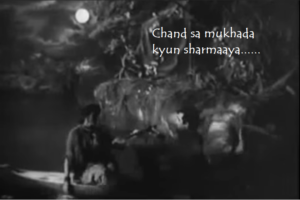 One of the more significant reasons is known to my close friends, which is my number one theme in songs: Chand. In my Facebook group Yaad Kiya Dil Ne (actually its predecessor Dil Ki Nazar Se), the very first Fest theme was Chand (Please see: ‘Hindi Songs And The Importance Of Chand‘). Indeed, Sunil Dutt is picturised with Madhubala in a fantasy scene of mine (Boat in a lake on a full moon light) in a song put together by lyricist Shailendra, composer SD Burman and singers Mohammad Rafi and Asha Bhosle: Chand sa mukhada kyun shrmaaya.
One of the more significant reasons is known to my close friends, which is my number one theme in songs: Chand. In my Facebook group Yaad Kiya Dil Ne (actually its predecessor Dil Ki Nazar Se), the very first Fest theme was Chand (Please see: ‘Hindi Songs And The Importance Of Chand‘). Indeed, Sunil Dutt is picturised with Madhubala in a fantasy scene of mine (Boat in a lake on a full moon light) in a song put together by lyricist Shailendra, composer SD Burman and singers Mohammad Rafi and Asha Bhosle: Chand sa mukhada kyun shrmaaya.
We have completed seventy-seven days of Raaga Based Songs of the Day. Our first post in the series was titled ‘Raaga Based Song Of The Day #1’ and the song was a Mohammad Rafi and Lata Mangeshkar song from the 1970 Shakti Samanta movie Pagla Kahin Ka: Tum mujhe youn bhula na paoge. It is in Raag Jhinjhoti, Tal Kaherava.
Our seventy-seventh post or the last post was titled ‘Raaga Based Song Of The Day #77‘ and the song was a Vani Jairam song from the 1971 Hrishikesh Mukherjee movie Guddi starring Jaya Bahaduri in the title role and Dharmendra: Bole re papihara, papihara. It is in Raag Mian Ki Malhar, Tal Kaherava.
This blog has a number of posts on Raaga based songs in Hindi movies titled similarly; for example: ‘The Best Raaga Based Songs in Hindi Movies – Raaga Bhimpalasi – Part I‘.
In the last seventy-seven days of sharing Raaga based songs of the day, I have given you songs based on Raag Jhinjhoti, Gara, Bhimpalasi, Madhuvanti, Shivaranjani, Bihag, Pahadi, Sarang, Pilu, Bhairavi, Khammaj, Charukesi, Kalyan or Yaman, Desh, Malgunji, Kirwani, Kedar, Bageshri, Megh Malhar, Bhupali, Ahir Bhairav, Malkaush, Mand, Adana, Kafi, Rageshri, Jaunpuri, Tilang, Janasammohini, Chayanat, Shuddha Kalyan, Gaur Sarang, Jogiya, Asavari, Maru Bihag, Durga, Lalit, Puria Dhanashri, Bhinna Sahdja, Sohani, Multani, Patdeep, Jaijaiwanti, Tilak Kamod, Hemant, Basant Mukhari, Gujri Todi, Kalavati, Hamir, Bhatiyar, Gawati, Shyam Kalyan, Gorakh Kalyan, Madhamat Sarang, Manj Khammaj, Darbari Kanada, Vibhas, Shankara, Bahar, Nand and Mian Ki Malhar; making it a total of 61 raagas. The raagas that have been repeated so far are Pahadi, the raaga of my home place in the Himalayas, Maru Bihag, Raag Kirwani, Jhinjhoti, Bhairavi, Gara, Basant Mukhari, Malkauns and Bhairavi. Today, I am repeating Raaga Mand.
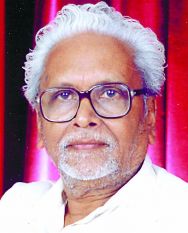
Today’s song has been sung by Lata Mangeshkar on the lyrics of Balkavi Bairagi and composition by Jaidev. As I said, it is in Raag Mand, Tal Kaherava. Finally, lets talk a bit about Balkavi Bairagi, poet, writer, and lyricist. He was born in village Rampur in Mandsaur district in Madhya Pradesh. Besides this song, he has another to his credit, also composed by Jaidev: Mujhako bhi Radha bana le Nandlal for the 1984 movie Ankahee.
Before we actually take up the song, first, lets take up the value added learning of today. We have already taken up quite a few Tala or Taals or Tals. Today, we shall take up Jhaptal. We haven’t taken up a single song in this tal but we shall do so shortly.
Jhaptal is one of the most common talas in Hindustani music after Tintal or Teental. It is a ten beat tal. These ten beats are arranged in four vibhags comprising clap, clap, wave, clap respectively. Jhaptal is used in a variety of classical and semiclassical settings. It may be found in the Khayal, Tarana, Bhajan, and Rabindra Sangeet, all of which we have learnt earlier. Series of Claps and Waves are: clap, 2, clap, 2, 3, wave, 2, clap, 2, 3. The Theka is:

Some of the songs with Jhaptal are: Awaz deke hamen na bulaao (Raag Shivaranjani), Aansu bhari hain ye jeevan ki raahen (Raag Kalyan), Bhaye bhanjana (Raag Mian Ki Malhar), Chali re chali re main to des praaye (Raag Tilak Kamod), Ghayal hiraniya (Raag Tilak Kamod), Masoom chehra (Raag Bhimpalasi), Pyara hamara munna (Raag Brindavani Sarang), Savere ka suraj tumhaare liye hai (Raag Kalyan), Sharaabi sharaabi ye sawan ka mausam (Raag Gaur Malhar), Sudh bisar gayi ajaa (Raag Hemant), Tumhen zindagi ke ujaale mubarak (Raag Darbari Kanada), and Zamaane ka dastoor hai ye puraana (Raag Kalyan).
As I said, today’s song is in Raag Mand, Tal Kaherava.
Raag Mand belongs to Bilawal Thaat. The other raagas belonging to this thaat are: Deskar, Hamsadhwani, and Bihag. In Bhatkhande’s system, the most basic Thaat is Bilawal. Raag Bilawal occurs in Sri Guru Granth Sahib exactly half way through, that is, it is the 16th raaga out of 31 raagas in SGGS. It occurs from page 795 to 859. In an Akhand Paath (unbroken recital), it normally occurs on the next day morning and hence it is easy to conclude that it is an early morning raaga.
Being the most basic Thaat, Bilawal is used as a reference Thaat for all other thaats. A thaat must have seven notes (swar) out of a total of twelve notes (seven shuddha, four komal (Re, Ga, Dha, Ni) and one teevra (Ma) placed in an ascending order. Hence, a thaat has only aaroha. It would be easy to visualise that thaats by themselves are not sung but the raagas belonging to them are sung. I have already told you that thaats are named after the popular raaga of that thaat; eg, Bhairavi is a thaat named after the raag Bhairavi.
One reason for Bilawal being the basic thaat is because all the swars in the thaat are shuddha, ie, in their natural scale. One never hears of Bilawal raaga these days except in SGGS. However, a variation of the raag called Alhaiya Bilawal is very common.
Raag Mand, belonging to Bilawal Thaat has all shuddha swar too. Its Jati is is Sampurna-Sampurna (Vakra). The best part of the raaga is that it is a light melody that sounds very natural (shuddha swar) but is rendered with great difficulty. No bandishes like bada-khayaals are rendered in this raaga. It is aptly suited for bhajans and ghazals. The basic format belongs to the folk tune of Rajasthan, which is the sung during festive occasions like birthdays, and marriages.
In the 1991 movie Lekin, a song in Raag Mand, Tal Dadra was sung by Lata Mangeshkar, my favourite female singer in the movies, ie, Kesariya baalma. Indeed, if you look at the list of songs in Raag Mand, you would see that most of these have been sung by Lata Mangeshkar. Here is a representative list:
| 1. 2. 3. 4. 5. 6. 7. 8. 9. 10. 11. 12. 13. |
Kise Karta Moorakh Mushqil Hai Bahut Muhkil Bachpan Ki Mohabbat Dekh Liya Main Ne Jo Main Janati Bala Main Bairagan Do Dil TooteAb To Hai Tumse Thade Rahiyo Aaj Sach Hua Kesariya Balamaa Aao gori Aao Shyama |
Achhuut Kanya Mahal Baiju Bawara Deedar Shabab Meera Heer RanjhaAbhimaan Pakeezah Swarg Narak Lekin Tansen |
Ashok Kumar Lata Lata Lata, Rafi Lata Vani Jayaram LataLata Lata Lata Lata Khursheed |
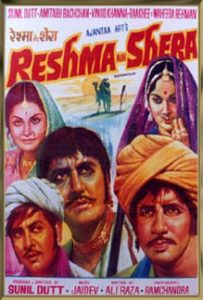
The song Tu chanda main chandani is from the 1971 Sunil Dutt movie Reshma Aur Shera starring Sunil Dutt and Waheeda Rehman. It was well received by the critics internationally and was nominated for the Golden Bear at the 22nd Berlin International Film Festival. It was selected as the Indian entry for the Best Foreign Language Film at the 44th Academy Awards but was not accepted as a nominee.
Please enjoy in Raag Mand, Tal Kaherava: Tu chanda main chandani…….
Tuu cha.ndaa mai.n chaa.ndanii, tuu taruvar mai.n shaakh re
Tuu baadal mai.n bijurii, tuu pa.nchhii mai.n paat re
Naa sarovar, naa baava.Dii, naa koI Tha.nDii chhaa.nv
Naa koyal, naa papiiharaa, aisaa meraa gaa.nv re
Kahaa.N bujhe tan kii tapan, o saiyaa.n siramol
Cha.ndra-kiran to chho.D kar, jaae kahaa.N chakor
Jaag uThii hai saa.nvare, merii kuaa.nrii pyaas re
(Piyaa) a.ngaare bhii lagane lage aaj mujhe madhumaas re
Tujhe aa.nchal mai.n rakhuu.Ngii o saa.nvare
Kaalii alako.n se baa.Ndhuu.Ngii ye paa.nv re
Chal baiyaa.N vo Daaluu.n kii chhuuTe nahii.n
Meraa sapanaa saajan ab TuuTe nahii.n
Me.nhadii rachii hatheliyaa.N, mere kaajar-vaale nain re
(Piyaa) pal pal tujhe pukaarate, ho ho kar bechain re
O mere saavan saajan, o mere si.nduur
Saajan sa.ng sajanii banii, mausam sa.ng mayuur
Chaar pahar kii chaa.ndanii, mere sa.ng biThaa
Apane haatho.n se piyaa mujhe laal chunar u.Dhaa
Kesariyaa dharatii lage, ambar laalam-laal re
A.ng lagaa kar saahib re, kar de mujhe nihaal re
We have intended to learn about Raaga based music whilst we entertain ourselves with Raaga based songs. So, lets, once again, take stock of our collective learning so far:
- On the first day we learnt about the Raaga system devised by Pandit Vishnu Narayan Bhatkhande, which is the prevalent system in Hindustani Classical Music and based on ten Thaats.
- On the second day we learnt about Tal or Taal.
- On the third day we learnt about characteristics of Raagas that included Swar, Jati, Thaat, Arohana and Avarohana, Vadi, Samvadi and Pakad.
- On the fourth day, we learnt about Sargam.
- On the fifth day, we learnt about notations used in Indian classical music or simply Swar Lipi.
- On the sixth day, we learnt about the Ras (sentiments) that Raagas evoke.
- On the seventh day, we learnt about various types of Swar: Shuddha, Achal, Vikrut, Komal and Teevra.
- On the eighth day, we learnt the parts of a composition in Indian Classical Music.
- On the ninth day, we learnt the names of some of the popular instruments used in Indian Classical Music.
- On the tenth day, we learnt about the sources of names of Raagas.
- On the eleventh day, we learnt about why Bhairavi is the first raag to be taught to beginners and also why it is the last in a performance.
- On the twelfth day, we learnt about Khammaj Thaat.
- On the thirteenth day, we learnt about Tal Punjabi Theka or Sitarkhani.
- On the fourteenth day, we learnt about Alap.
- On the fifteenth day, we learnt about List of Raagas (Raagmala) in my favourite book: Sri Guru Granth Sahib.
- On the sixteenth day, we learnt about tips for raaga identification.
- On the seventeenth day, we learnt the basics of Gharana system.
- On the eighteenth day, we learnt about Filmi Sangeet.
- On the nineteenth day, we learnt about the commonest Tal in Raagas: Tintal.
- On the twentieth day, we learnt about the Kafi Thaat.
- On the twenty-first day, we learnt a little more in detail about the classification of Raagas.
- On the twenty-second day, we learnt the essential differences between Bhairavi and Bhairav.
- On the twenty-third day, we learnt a little more in detail about the Jati or Jaati of a raaga.
- On the twenty-fourth day, we learnt details of Thaat Bilawal, the most basic thaat in the Bhatkhande’s system of raagas.
- On the twenty-fifth day, we learnt about Tintal.
- On the twenty-sixth day, we learnt in detail about the Raaga – Samay linkage.
- On the twenty-seventh day, we learnt about Lehar.
- On the twenty-eighth day, we learnt about the history of the Hindustani Music.
- On the twenty-ninth day, we learnt about Dhrupad.
- On the thirtieth day, we learnt about Rupaktal that I was introduced to, a few months back, by my friend Anand Desai.
- On the thirty-first day, we learnt about Khayal.
- On the thirty-second day, we learnt about Thumri.
- On the thirty-third day, we learnt about Tappa.
- On the thirty-fourth day, we learnt about Tarana.
- On the thirty-fifth day, we learnt about Tal Dipchandi (Moghali).
- On the thirty-sixth day, we learnt about Tabla.
- On the thirty-seventh day, we learnt about Kirtan.
- On the thirty-eighth day, we learnt about Pakhawaj.
- On the thirty-ninth day, we learnt about Hori.
- On the fortieth day, we learnt about Dadra.
- On the forty-first day, we learnt about Kajri.
- On the forty-second day, we learnt about Chaiti.
- On the forty-third day, we learnt about Sarangi.
- On the forty-fourth day, we learnt about Shehnai.
- On the forty-fifth day, we learnt about Sarod.
- On the forty-sixth day, we learnt about Bansuri.
- On the forty-seventh day, we learnt about Ektal and Tanpura.
- On the forty-eighth day, we learnt about Veena.
- On the forty-ninth day, we repeated our learning of Veena with a small excitement added.
- On the fiftieth day, we learnt about Dilruba/Esraj.
- On the fifty-first day, we learnt about Jaltarang.
- On the fifty-second day we learnt about Qawwali.
- On the fifty-third day, we learnt about Sitar.
- On the fifty-fourth day, we learnt about Surbahar.
- On the fifty-fifth day, we learnt about Harmonium.
- On the fifty-sixth day, we learnt about Santoor.
- On the fifty-seventh day, we learnt about Swarmandal.
- On the fifty-eighth day, we learnt about the Shruti Box.
- On the fifty-ninth day, we learnt about Alankar.
- On the sixtieth day, we learnt about singing in Aakaar.
- On the sixty-first day, we learnt about the Classification of Indian Musical Instruments.
- On the sixty-second day, we learnt a little about Carnatic Music.
- On the sixty-third day, we learnt about Natya Shastra.
- On the sixty-fourth day, we learnt about evolution of musical instruments in India down the ages.
- On the sixty-fifth day, we learnt about Riyaaz.
- On the sixty-sixth day, we looked at a list of Raagas in Hindustani Classical Music.
- On the sixty-seventh day, we learnt about the health benefits of raagas.
- On the sixty-eighth day, we learnt a little more comprehensively about the moods and emotions that raagas evoke.
- On the sixty-ninth day, we learnt about a mobile application to help identify raagas.
- On the seventieth day, we learnt about Melakarta Raagas.
- On the seventy-first day, we learnt about Sangita Makarand.
- On the seventy-second day, we learnt about TaalMala an Android application for personalized accompaniment of musical instruments during Riyaaz or even during Concert.
- On the seventy-third day, we learnt about Indian Classical Ragas, an Android application for mobile phones.
- On the seventy-fourth day, we learnt about Saregama Classical, another application for Classical Raagas.
- On the seventy-fifth day, we learnt about a free online service available to learn Indian Classical Music.
- On the seventy-sixth day, we learnt about List of Hindustani Classical Musical Festivals in India and Abroad.
- On the seventy-seventh day, we learnt about List of Carnatic Musical Festivals in India and Abroad.
- And today, on the seventy-eighth day, we learnt about Jhaptal.
There is much more still to be learnt and enjoyed.
Please stay tuned!
